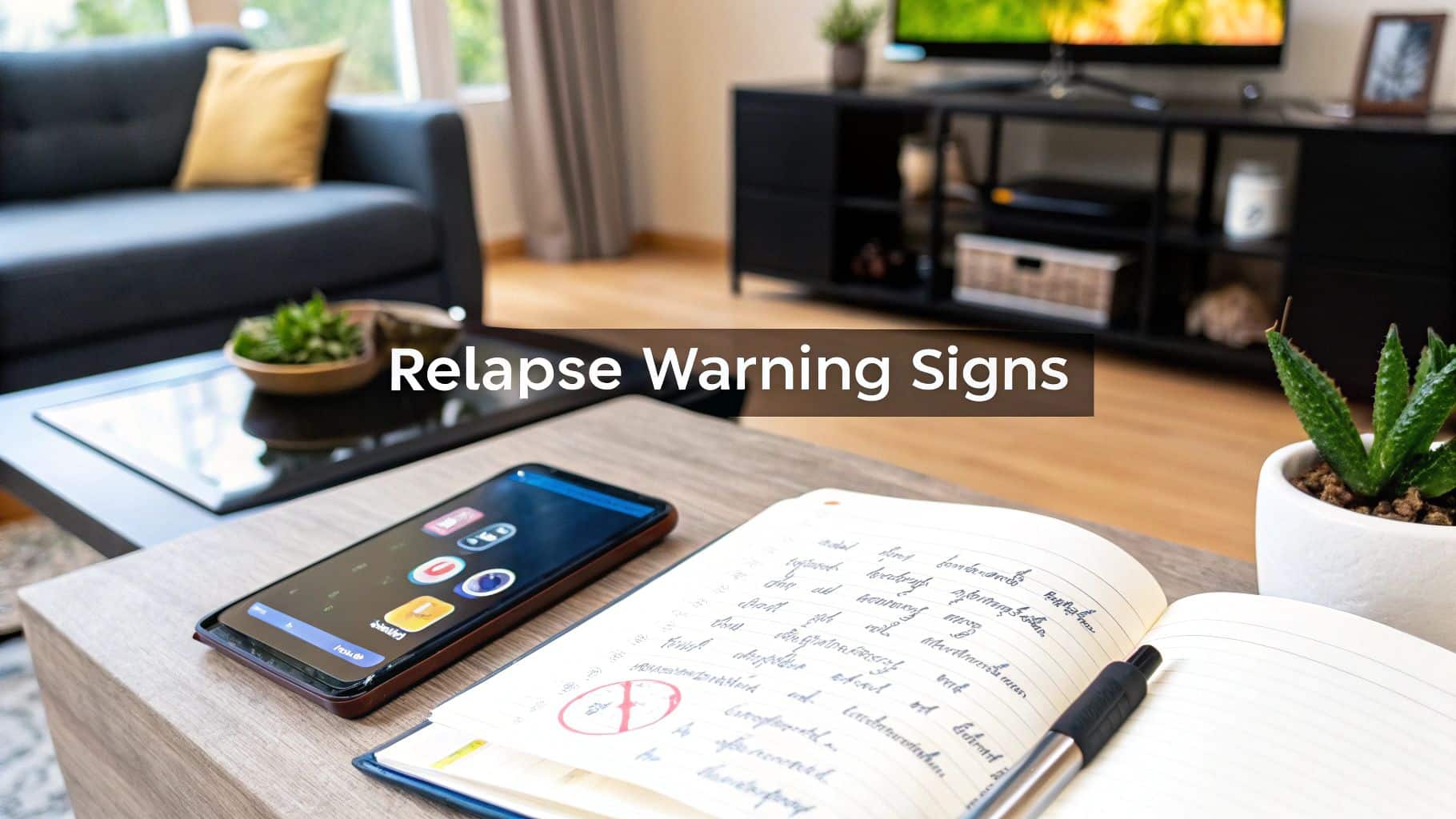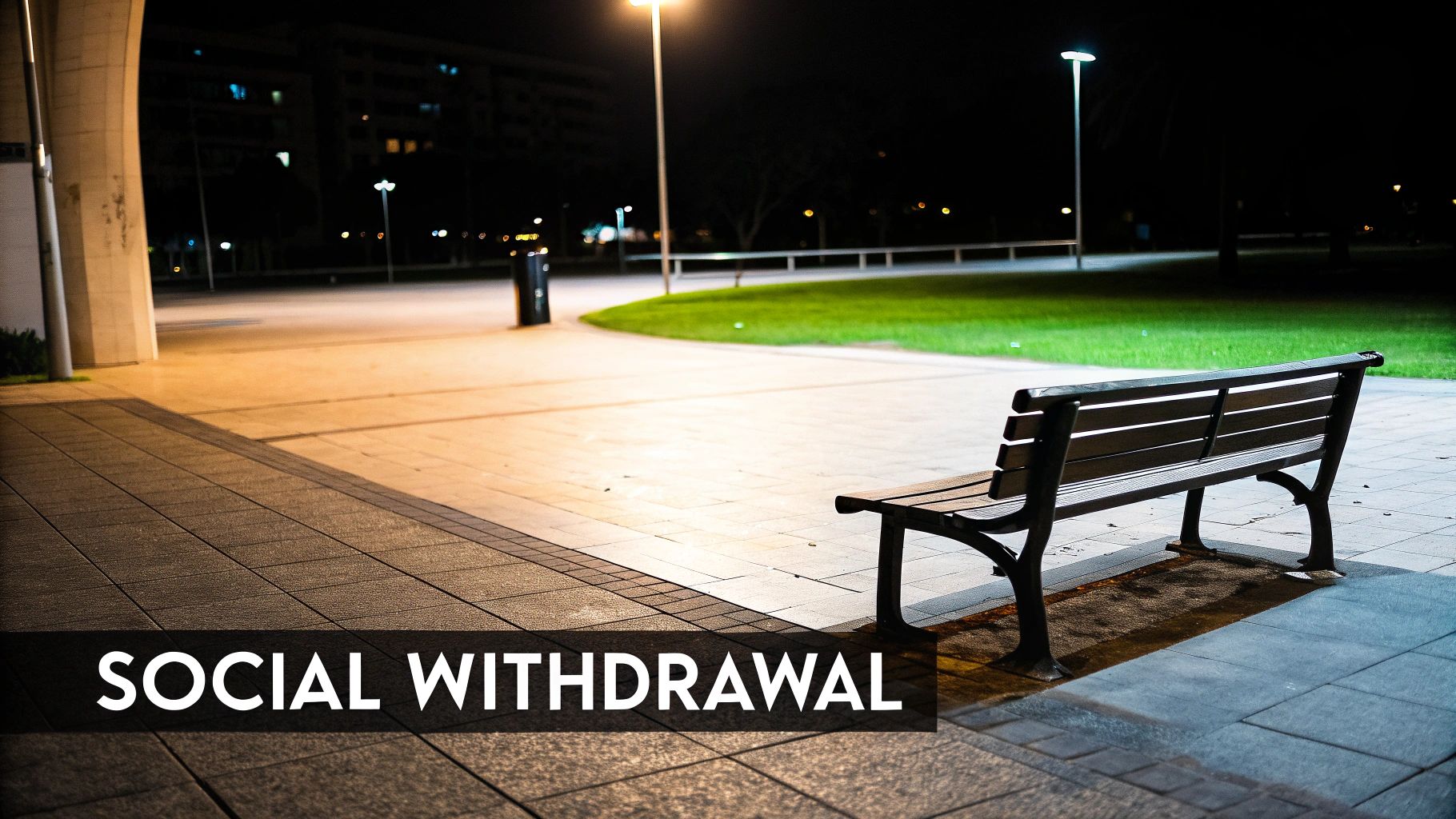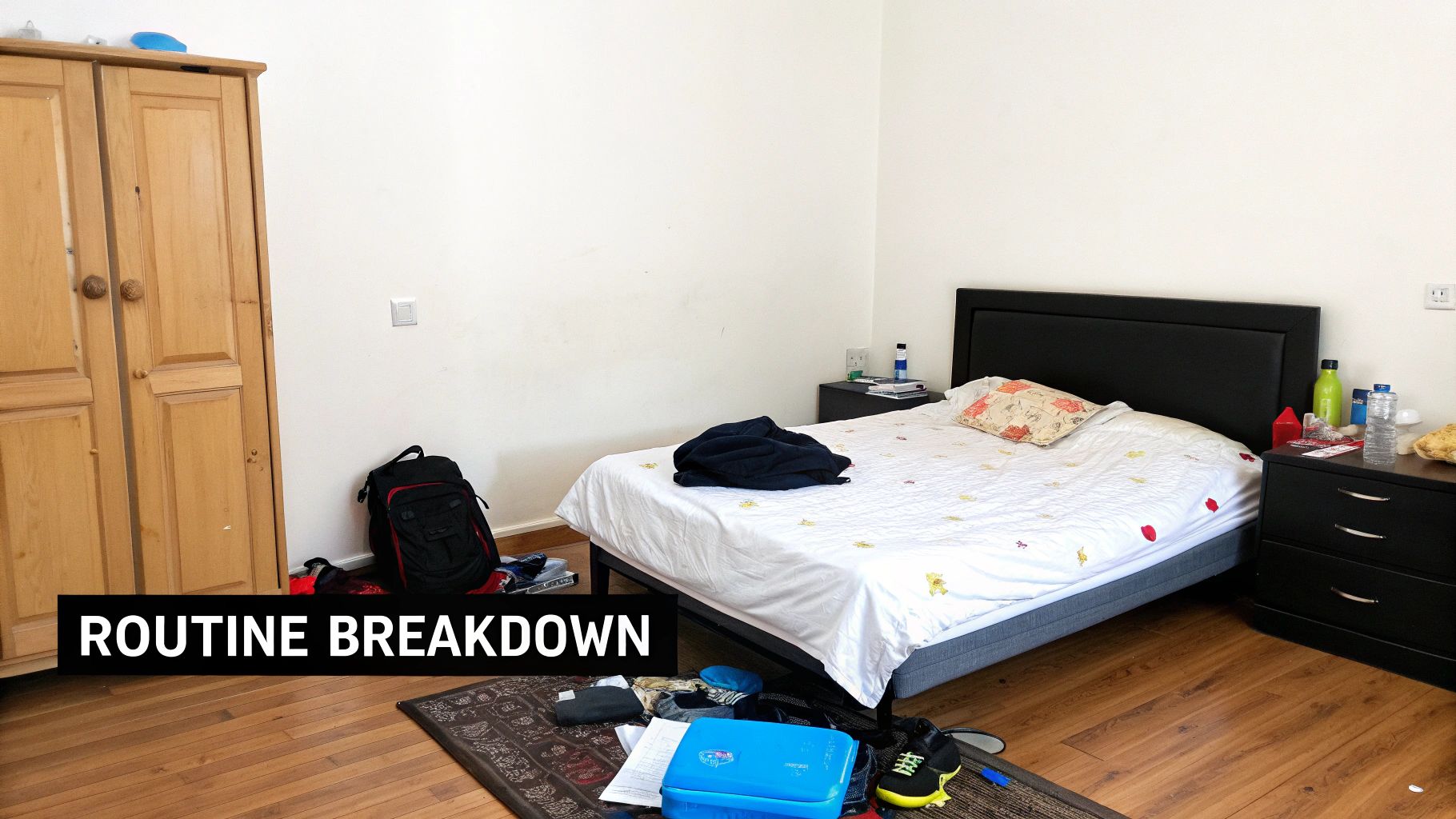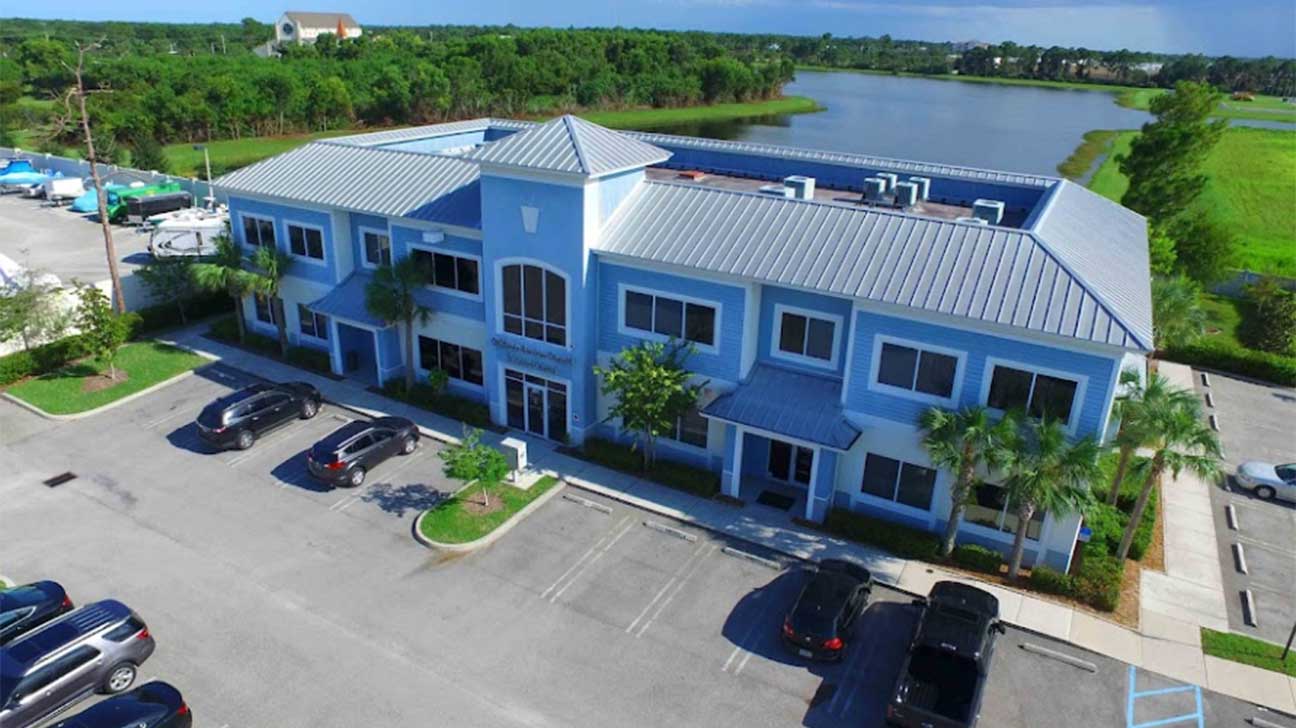
Understanding the Subtle Signals: Navigating the Path to Lasting Recovery
Recovery from addiction is a transformative journey, but it is rarely a straight line. The path is often marked by progress and potential pitfalls. One of the greatest challenges is the risk of relapse, which seldom happens spontaneously. Instead, it is typically preceded by a series of subtle but significant changes in thinking, feeling, and behavior. Recognizing these relapse warning signs is not about fearing failure; it’s about empowering yourself with the awareness needed to take corrective action and strengthen your sobriety.
This guide is designed to be an in-depth resource, moving beyond surface-level advice to explore the seven most critical relapse warning signs in detail. We will dissect the emotional, cognitive, and behavioral indicators that signal a potential return to substance use. Inside, you will find:
- A detailed breakdown of each warning sign.
- Real-world examples to make these concepts clear.
- Actionable strategies to help you or a loved one stay on track.
By understanding these signals, you can build a more resilient recovery foundation. This knowledge equips you to identify high-risk situations early, implement effective coping strategies, and navigate the challenges of long-term recovery with confidence.
1. Emotional Dysregulation
Emotional dysregulation, a core concept in Dialectical Behavior Therapy (DBT) pioneered by Dr. Marsha Linehan, is one of the most significant relapse warning signs. It refers to an inability to manage emotional responses in a healthy, controlled manner. Instead of processing feelings constructively, a person experiences intense, overwhelming emotional reactions that are disproportionate to the situation. This can manifest as extreme mood swings, sudden bursts of anger, profound anxiety, or a disorienting sense of emotional numbness.

This state is a critical precursor to relapse because it severely impairs judgment and problem-solving skills. When emotions become unmanageable, the brain’s prefrontal cortex, responsible for rational decision-making, is essentially hijacked. In this vulnerable state, returning to substance use can feel like the only way to escape the emotional turmoil, offering a familiar, albeit destructive, coping mechanism.
### Examples of Emotional Dysregulation in Recovery
Recognizing these patterns is crucial. For instance, a person in long-term recovery might suddenly find themselves becoming intensely agitated over a minor disagreement with a coworker, leading to hours of obsessive thinking. Another example is someone who, after months of stability, begins experiencing debilitating anxiety attacks that interfere with daily life. It can also appear as emotional withdrawal, where an individual becomes detached and numb, pulling away from supportive friends and family because engaging feels too exhausting.
### How to Manage Emotional Dysregulation
Proactively addressing emotional dysregulation can fortify your recovery. Here are specific, actionable strategies:
- Implement Daily Mood Tracking: Use a journal or a mood-tracking app (like Daylio or MoodPanda) to log your emotional state multiple times a day. Note the intensity of the emotion and any potential triggers. This creates a data-driven awareness of your emotional patterns, helping you and your therapist identify emerging risks.
- Practice Grounding Techniques: When you feel an emotional storm brewing, use the 5-4-3-2-1 grounding technique. Identify five things you can see, four you can touch, three you can hear, two you can smell, and one you can taste. This pulls your focus away from the overwhelming emotion and back to the present moment.
- Establish a Support System Check-in: Create a structured plan with your sponsor, therapist, or a trusted friend. For example, agree to send a text or make a quick call whenever your mood drops below a certain level or anxiety spikes. This creates an immediate support circuit before the dysregulation can escalate into a full-blown crisis.
2. Social Isolation and Withdrawal
Social isolation and withdrawal from a supportive community is one of the most dangerous relapse warning signs. This behavior involves intentionally pulling away from the people, meetings, and activities that form the foundation of a strong recovery. Core tenets of successful recovery programs, from the fellowship principles of Alcoholics Anonymous to Dr. Alan Marlatt’s relapse prevention model, emphasize the power of connection. Isolation systematically dismantles this crucial support network, leaving an individual alone with their thoughts and cravings.

This retreat into solitude creates a vacuum that is often filled by old, destructive thought patterns. Without the accountability and perspective provided by peers, sponsors, and therapists, a person’s own rationalizations and justifications for returning to substance use can grow unchecked. Connection acts as a buffer against stress and a reality check for distorted thinking; removing it significantly increases relapse risk.
### Examples of Social Isolation in Recovery
Recognizing the subtle drift toward isolation is key. For example, a person who was once a fixture at their weekly support group meetings might start missing them, first claiming to be “too busy” and then stopping altogether. Another common scenario is an individual in recovery who begins consistently declining invitations from sober friends, opting to stay home instead. It can also manifest as avoiding family events or phone calls, creating distance from the very people who offer unconditional support.
### How to Counteract Social Isolation
Staying connected requires deliberate and proactive effort. Here are specific strategies to maintain your support system:
- Establish an Accountability ‘Buddy System’: Partner with another person in recovery. Agree to a non-negotiable check-in schedule, such as a brief daily text or a call three times a week. The goal is simple connection and accountability, providing a low-pressure way to stay engaged even on difficult days.
- Schedule Mandatory Check-ins: Treat appointments with your sponsor, therapist, or counselor as unmovable commitments. Schedule these sessions in advance and protect that time fiercely. This ensures you maintain a professional support anchor in your recovery, especially when you feel like withdrawing.
- Set a Minimum Social Activity Goal: As part of your recovery plan, define a minimum social engagement quota for the week. This could be attending two meetings, having one coffee with a sober friend, or making one phone call to a supportive family member. This transforms connection from a mood-dependent activity into a structured, essential part of your routine.
3. Neglecting Self-Care and Routine
The breakdown of fundamental self-care practices and daily routines is one of the most visible and telling relapse warning signs. This goes far beyond just feeling a bit “off.” It signifies a conscious or subconscious abandonment of the very structures that support physical and mental stability in recovery. When individuals stop prioritizing basic needs like nutrition, hygiene, exercise, and sleep, they erode their own foundation, leaving them physically depleted and psychologically vulnerable.

This neglect is a critical red flag because it directly impacts mood, energy levels, and cognitive function, creating a state that mirrors the conditions leading to initial substance use. Concepts like HALT (Hungry, Angry, Lonely, Tired), central to many recovery programs, highlight how these basic physical and emotional states can trigger cravings. A poorly nourished, sleep-deprived brain is far more susceptible to impulsive decisions and less capable of utilizing healthy coping skills when faced with stress. The connection between mind and body is essential, a core principle in holistic treatment approaches.
### Examples of Neglecting Self-Care in Recovery
These shifts are often gradual but become obvious over time. For instance, a person who meticulously planned healthy meals might start relying entirely on fast food or skip meals altogether. Someone who previously took pride in their appearance may suddenly look disheveled and stop caring about personal hygiene. Another clear example is the disruption of sleep patterns, such as someone who maintained a consistent schedule now sleeping for 12+ hours a day or, conversely, suffering from chronic insomnia and restlessness.
### How to Maintain Self-Care and Routine
Fortifying your self-care practices is a non-negotiable part of relapse prevention. Here are concrete strategies to stay on track:
- Create a Daily Non-Negotiable Checklist: Design a simple checklist for your morning and evening routines. Include 3-5 absolute “non-negotiables” like “take medication,” “brush teeth,” “eat a balanced breakfast,” or “10-minute walk.” Physically checking off items creates a sense of accomplishment and reinforces the routine.
- Set Phone Reminders for Basic Needs: Use your phone’s calendar or reminder app to schedule self-care. Set an alarm for lunchtime, a reminder to drink water every hour, and an alert an hour before bedtime to start winding down. This automates the process and reduces reliance on a compromised executive function.
- Establish a “Self-Care Check-in” Partner: Designate a trusted friend, family member, or sponsor to ask you specific, direct questions regularly. Instead of a generic “how are you,” they can ask, “Did you get some exercise today?” or “What did you have for dinner?” This accountability makes it harder to let self-care slide unnoticed.
Call Now – Your Journey to Recovery Begins Today!

Take the first step towards a healthier life! Call now to connect with our compassionate team and start your recovery journey today. Your path to healing awaits!
Our recovery specialists are available 24/7 to provide support, and all calls are confidential and free. Reach out anytime – we’re here to help!
4. Romanticizing Past Substance Use
Romanticizing past substance use is a subtle yet powerful cognitive distortion that stands as one of the most dangerous relapse warning signs. Often referred to as “euphoric recall,” this thinking pattern involves selectively remembering the perceived positive aspects of addiction while conveniently forgetting or downplaying the severe negative consequences. This cognitive trap, highlighted in models like Gorski-Cenaps relapse prevention and addressed in Cognitive Behavioral Therapy (CBT), creates a distorted reality where the past seems more appealing than the present.

This mental revisionism is a critical threat to sobriety because it chips away at the motivation for recovery. By minimizing the pain, chaos, and destruction caused by addiction, a person can begin to question the necessity of their sober life. The mind starts to believe a dangerous lie: that using or drinking was not “that bad” and that a return to substance use might solve current life stressors. This makes relapse seem like a logical, even desirable, choice rather than a catastrophic step backward.
### Examples of Romanticizing in Recovery
Identifying this thought pattern is key to stopping its progression. For example, a person might start sharing “funny” stories about their past drinking escapades at social gatherings, carefully omitting the parts about blackouts, arrests, or relationship damage. Another instance is when an individual, facing a difficult day at work, begins thinking, “Life was so much simpler when all I had to worry about was getting high.” This can also manifest as a person starting to question the severity of their problem, wondering if they could become a “social” user now that they’ve had some sober time.
### How to Counteract Romanticizing Past Use
Challenging these distorted thoughts with deliberate action is essential for maintaining a strong recovery. Here are specific strategies to implement:
- Create a “Consequence Card”: Write a detailed, honest list of the most painful and destructive consequences of your past substance use. Include financial ruin, damaged relationships, legal troubles, and health problems. Keep this list on a small card in your wallet or as a note on your phone. Review it immediately whenever nostalgic thoughts arise to ground yourself in reality.
- Practice Active Gratitude for Sobriety: Start or end each day by listing three specific things you have now that you didn’t have during active addiction. This could be a stable job, peace of mind, mended family ties, or simply waking up without withdrawal symptoms. This practice shifts your focus from a fantasy past to the tangible benefits of your present life.
- Commit to Immediate Disclosure: Make a pact with your sponsor, therapist, or a trusted peer in recovery to voice these thoughts as soon as they appear. Saying “I’m starting to think about the good times” out loud robs the thought of its power and allows your support system to remind you of the reality you’ve escaped.
5. Increasing Stress Without Healthy Coping
The accumulation of life stressors without the use of healthy coping mechanisms is a powerful and insidious relapse warning sign. Concepts from Dr. Aaron Beck’s cognitive therapy and Mindfulness-Based Stress Reduction (MBSR) highlight that it’s not stress itself, but our response to it, that dictates our vulnerability. When stressors pile up, be they financial, relational, or professional, the natural impulse for someone in recovery can be to revert to old, maladaptive thought patterns. The substance that once offered a quick, albeit destructive, escape from pressure begins to look like a viable solution again.
This state is dangerous because chronic, unmanaged stress depletes our cognitive resources. It weakens our capacity for impulse control and rational thinking, which are the very skills needed to maintain sobriety. The mind starts to believe the false narrative that “I can’t handle this,” and the old coping mechanism of substance use presents itself as the only way to get relief. Recognizing this shift from actively managing stress to being overwhelmed by it is crucial for preventing a return to use.
### Examples of Unmanaged Stress in Recovery
Spotting this pattern early is key to intervention. For example, a person might lose their job and, instead of leaning on their support network or practicing mindfulness, they begin isolating themselves and ruminating on their failure. Another instance is someone facing escalating conflict in their relationship who starts avoiding conversations and staying out late, reverting to avoidance behaviors. It can also be an individual experiencing financial strain who abandons their daily meditation and exercise routine because they feel “too busy” or “too stressed” to bother, removing the very tools that could help them.
### How to Manage Increasing Stress
Building a resilient defense against stress requires proactive and consistent effort. The goal is to make healthy coping your default response. To learn more about building these defenses, explore these comprehensive relapse prevention strategies on addictionhelplineamerica.com.
- Develop a Written Stress Management Plan: Don’t wait for a crisis. Create a written, tiered plan. For “Level 1” stress (e.g., a bad day at work), your plan might be a 20-minute walk. For “Level 2” (e.g., a major argument), it might be calling your sponsor. For “Level 3” (e.g., a job loss), it could involve scheduling an emergency therapy session.
- Practice Proactive Stress Reduction: Integrate stress-reduction techniques into your daily life, not just during high-stress moments. Dedicate 10 minutes each morning to mindfulness meditation or deep breathing exercises. This builds your “stress tolerance muscle” so it’s strong when you need it.
- Identify Early Warning Signs: Work with a therapist or sponsor to identify your personal, subtle signs of rising stress. Do you clench your jaw? Do you start skipping meals? Recognizing these physical or behavioral cues allows you to intervene before the stress becomes overwhelming.
6. Dishonesty and Secretive Behavior
The return of dishonesty and secretive behavior is one of the most dangerous relapse warning signs because it directly dismantles the foundations of accountability and trust essential for recovery. This behavior, strongly emphasized in 12-Step programs and therapeutic communities, involves more than just outright lies. It includes omissions, half-truths, and a general lack of transparency about activities, finances, feelings, or relationships, creating a hidden life where addictive behaviors can fester.
This pattern is a critical sign of relapse because it mirrors the exact deceptive habits that enabled active addiction. Secrecy creates isolation, and isolation is the enemy of recovery. By concealing their actions or true feelings, individuals cut themselves off from their support network. This breakdown in communication prevents them from receiving help, course correction, or empathy, leaving them alone with the very thoughts and urges they are trying to overcome.
### Examples of Dishonesty in Recovery
Recognizing these behaviors early is key. For example, a person might start claiming they attended a support group meeting when they actually skipped it to do something else. Another common instance is lying about financial matters, such as hiding a large purchase or being vague about where money was spent. It can also manifest as being secretive about new friendships or romantic interests, especially if those individuals are not supportive of recovery, effectively hiding a potential source of negative influence.
### How to Counteract Dishonesty
Building a fortress of honesty around your recovery is a proactive defense. Here are specific, actionable strategies:
- Practice Radical Honesty on Small Things: Make a conscious effort to be rigorously honest about minor, everyday things. Admit when you’re running five minutes late or when you forgot to do a chore. This builds the “honesty muscle,” making it easier to be truthful when facing more significant challenges.
- Establish Accountability Check-ins: Arrange with a sponsor or trusted peer to have brief, structured check-ins with specific questions. For instance, “Did you go to your meeting today?” or “Have you had any thoughts of using?” This removes the gray area and makes it harder for dishonesty to take root.
- Address Dishonesty Immediately: If you catch yourself in a lie, however small, correct it immediately with the person you were dishonest with. This practice, often called “coming clean,” reduces the shame and guilt that fuel further deception and reinforces your commitment to a transparent recovery process.
7. Overconfidence and Complacency
Overconfidence and complacency are insidious relapse warning signs because they masquerade as strength. This state, sometimes referred to as “spiritual pride” in 12-step literature, involves developing an inflated sense of control over one’s addiction. A person begins to believe they have completely “conquered” the problem, viewing their recovery routines as optional rather than essential for continued stability. This false security dismantles the very structure that supports their sobriety.
This mindset is a critical threat to long-term recovery. When an individual feels cured, they stop actively engaging in the daily maintenance that keeps addiction at bay. The vigilance required to identify triggers and manage cravings diminishes, leaving them exposed. Complacency creates a dangerous blind spot, making a person believe they can safely navigate high-risk situations that were previously off-limits, often with disastrous consequences.
### Examples of Overconfidence and Complacency in Recovery
Recognizing these subtle shifts in attitude is key. For example, a person who has been sober for a year might decide they no longer need their weekly support group meetings, thinking they have “graduated.” Another classic example is someone who starts reconnecting with old using friends, convinced their newfound willpower will protect them from being influenced. It can also manifest as intentionally going to bars or parties where alcohol is central, purely to “test” their resolve, a high-stakes gamble driven by pride.
### How to Manage Overconfidence and Complacency
Staying grounded is vital for sustainable recovery. Here are specific strategies to combat this dangerous mindset:
- Review Your Addiction History: Regularly revisit your “first step” or the story of how your addiction progressed. Reread old journal entries or talk to a sponsor about the realities of your past. This practice serves as a potent reminder that addiction is a progressive condition that requires continuous management.
- Embrace Humility Through Service: Actively engage in service work. This could mean sponsoring someone newer in recovery, volunteering at a meeting, or helping out in your community. Service shifts the focus from self to others, which is a powerful antidote to the ego-driven nature of overconfidence.
- Create Clear Boundaries for High-Risk Situations: Instead of relying on in-the-moment willpower, work with a therapist or mentor to create non-negotiable rules. For example, a rule might be, “I will not attend events where the primary activity is drinking” or “I will always have a planned exit strategy and my own transportation.” For more ideas, you can learn more about how to prevent relapse on addictionhelplineamerica.com.
- Schedule a “Complacency Check-in”: Set a recurring calendar reminder (e.g., monthly) to ask for honest feedback from your sponsor, therapist, or a trusted recovery peer. Ask them directly, “Have you noticed any signs of overconfidence or complacency in my attitude or actions lately?” This invites accountability and external perspective.
Call Now – Your Journey to Recovery Begins Today!

Take the first step towards a healthier life! Call now to connect with our compassionate team and start your recovery journey today. Your path to healing awaits!
Our recovery specialists are available 24/7 to provide support, and all calls are confidential and free. Reach out anytime – we’re here to help!
7 Key Relapse Warning Signs Comparison
| Warning Sign | Implementation Complexity 🔄 | Resource Requirements ⚡ | Expected Outcomes 📊 | Ideal Use Cases 💡 | Key Advantages ⭐ |
|---|---|---|---|---|---|
| Emotional Dysregulation | Moderate – requires therapeutic intervention | Moderate – mood tracking, therapy | Improved emotional control, reduced relapse | Individuals with intense mood swings or anxiety | Easily recognizable, clear triggers |
| Social Isolation and Withdrawal | Low – mainly observational and social support | Low to moderate – social reintegration | Re-engagement with support systems | Those avoiding social or recovery group contact | Easily observable, reversible with support |
| Neglecting Self-Care and Routine | Low – behavioral adjustments | Low – routine checklists, reminders | Enhanced physical and mental well-being | Individuals abandoning daily self-care habits | Visible to close contacts, quick improvement |
| Romanticizing Past Substance Use | Moderate – cognitive behavioral interventions | Moderate – therapy and self-monitoring | Corrected cognitive distortions, relapse prevention | Those nostalgic about substance use | Offers therapeutic insight, indicates trauma work |
| Increasing Stress Without Healthy Coping | Moderate – requires stress management training | Moderate – education, lifestyle changes | Better stress handling, reduced relapse risk | Individuals overwhelmed by life stressors | Identifiable triggers, responsive to intervention |
| Dishonesty and Secretive Behavior | Moderate to High – accountability systems | Moderate – monitoring, counseling | Restored trust, early relapse identification | Those exhibiting deceptive behaviors | Detectable by support network, targets vulnerabilities |
| Overconfidence and Complacency | Moderate – ongoing education and feedback | Low to moderate – mentorship | Maintained vigilance, prevention of risky behavior | Individuals with inflated self-efficacy | Reflects growth potential, can build healthy confidence |
Building a Proactive and Resilient Recovery
Navigating the path of sobriety is a journey of continuous growth, not a destination you reach and forget. Throughout this guide, we have explored the critical relapse warning signs that can surface, from the subtle shifts in emotional regulation and self-care to more overt behaviors like romanticizing past use or withdrawing from your support system. Understanding these signals is not about living in fear of a misstep; it is about empowering yourself with the knowledge to act decisively and protect the life you are building.
Think of these signs not as failures, but as invaluable data points. They are your personal early-warning system, alerting you that your recovery needs reinforcement. Each sign, whether it’s neglecting routines, feeling the pull of complacency, or struggling with unmanaged stress, is a clear indicator that it’s time to adjust your strategy. Recognizing them early transforms a potential crisis into an opportunity for growth, allowing you to strengthen your foundation before it’s ever truly tested.
From Awareness to Action: Your Next Steps
The true power of this knowledge lies in its application. Moving forward, the goal is to shift from a passive to a proactive stance in your recovery. Here are specific, actionable steps you can take today to build resilience against relapse:
- Conduct a Recovery Audit: Set aside 30 minutes this week to honestly assess your current state against the warning signs discussed. Go through the list: How is your self-care? Are you engaging with your support network? Have you been completely honest with your sponsor or therapist? Use a journal to write down your reflections and identify areas that need immediate attention.
- Update Your Relapse Prevention Plan: A static plan is a vulnerable one. Based on your audit, update your relapse prevention plan. If stress is a trigger, add a new, specific coping mechanism, like a weekly yoga class or daily 10-minute meditation. If you’ve been isolating, schedule three social check-ins for the upcoming week, even if they are just brief phone calls.
- Re-engage Your Support System: Proactively reach out to your support network. Do not wait for a crisis. Send a text to your sponsor, schedule a coffee with a trusted friend in recovery, or commit to attending an extra support group meeting this month. Vocalizing your commitment and potential struggles is one of the most powerful preventative tools you have.
The Lasting Value of Vigilance
Mastering the ability to identify these relapse warning signs is the cornerstone of a durable, long-term recovery. It allows you to address challenges when they are small and manageable, preventing them from escalating into overwhelming threats. This vigilance builds self-trust and demonstrates that you are capable of navigating the complexities of sobriety with skill and grace. Each time you recognize a warning sign and respond with a healthy action, you are not just avoiding relapse; you are actively strengthening your resolve and building a more resilient version of yourself. This proactive approach ensures that your recovery is not just about abstaining, but about thriving.
Your journey is a testament to your strength, and every day in recovery is a victory worth protecting. You are not alone in this process, and help is always within reach.
If you recognize these relapse warning signs in yourself or a loved one and need immediate, confidential support, do not hesitate to act. The professionals at Addiction Helpline America are available 24/7 to provide guidance, connect you with resources, and help you navigate this critical moment. Visit Addiction Helpline America or call their toll-free number to speak with someone who can help you reinforce your recovery today.
Our helpline is 100%
free & confidential
If you or someone you care about is struggling with drug or alcohol addiction, we can help you explore your recovery options. Don’t face this challenge alone—seek support from us.
Programs
Resources
Will my insurance
cover addiction
treatment?
We're ready to help
Find the best
drug or alcohol treatment
center
Are you or a loved one struggling with addiction? Call today to speak to a treatment expert.















